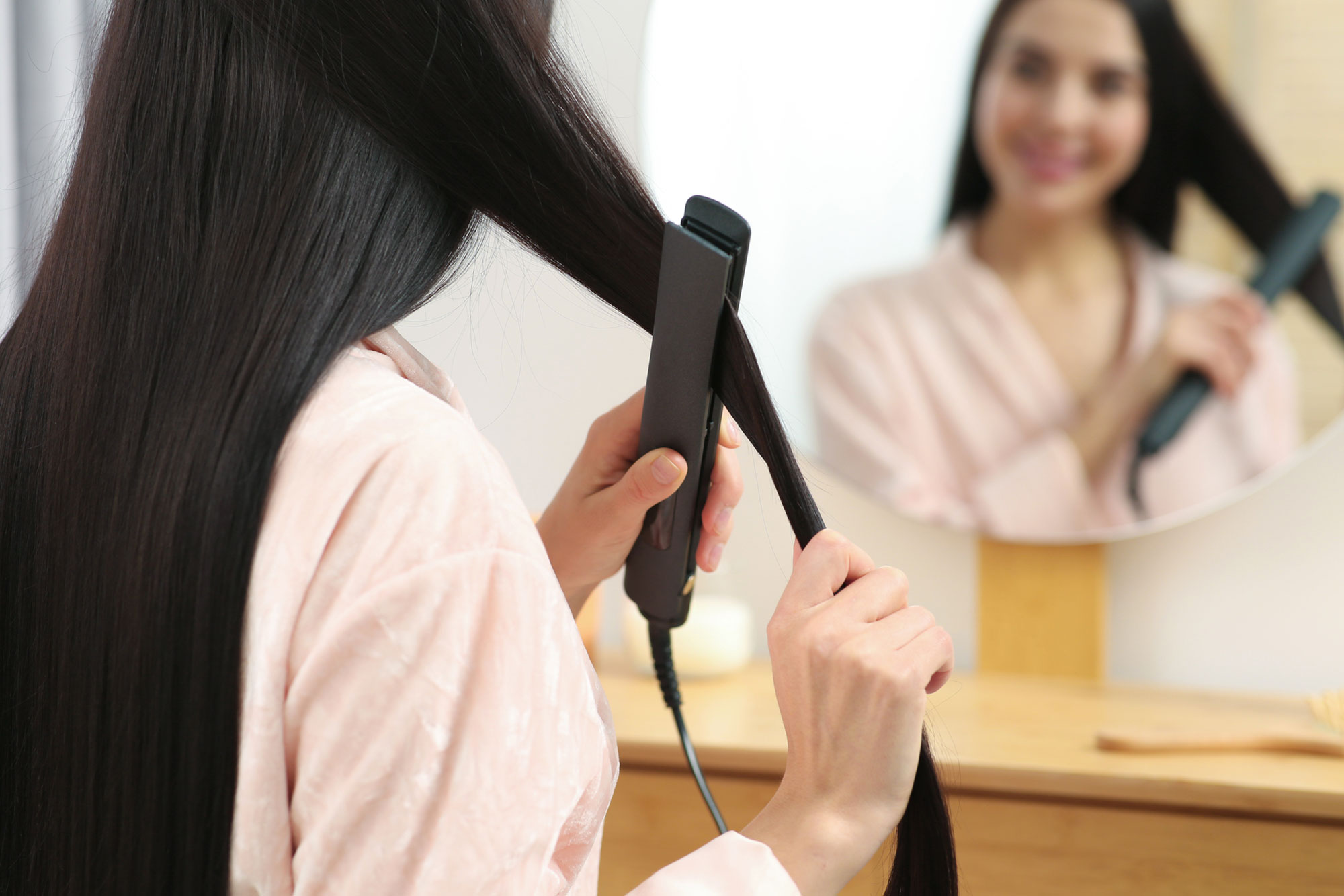The safe way to achieve perfectly straight hair
The Allure of Straight Hair
Straight hair is often associated with sleek elegance and ease of styling. However, achieving this look should be balanced with a commitment to maintaining hair health. This comprehensive guide offers insights into safely achieving perfectly straight hair, emphasising hair care and damage prevention.
Choosing the Right Tools: A Critical Step
The journey to straight hair starts with selecting the right tools. The market is flooded with various hair straighteners, but not all are created equal in terms of hair health. A highly recommended choice is the ghd new original hair straightener, renowned for its advanced technology that minimises hair damage while delivering excellent results. Remember, investing in the right tool is investing in the health of your hair.
Understanding Hair Types and Textures
Straightening different hair types requires understanding their unique characteristics. Fine hair, for instance, is more susceptible to heat damage, whereas coarse hair may require higher temperatures for effective straightening. If you’re looking to boost overall hair health, incorporating a hair growth serum into your routine can support stronger, healthier strands. Tailoring your approach to your hair type is key to achieving perfect results without compromising hair health.
Preparation: The Foundation of Safe Straightening
Before using any heat tools, preparation is crucial. Start with clean, dry hair, as straightening damp hair can cause significant damage. Apply a high-quality heat protectant to shield your hair from potential heat damage. This step cannot be overstressed, as it plays a vital role in maintaining hair integrity.

Effective Straightening Techniques
Achieving perfectly straight hair is more than just running a flat iron through your locks. Section your hair to ensure even heat distribution. Begin at the lowest temperature setting that effectively straightens your hair, and avoid repeatedly going over the same section. Slow, steady strokes from root to tip helps in achieving a sleek finish.
Temperature Matters: Finding the Right Heat Setting
The temperature setting on your straightener plays a pivotal role in hair health. Fine or damaged hair requires lower temperatures, typically between 300-350°F, while thicker, coarser hair may need temperatures up to 400-450°F. Regularly using high temperatures on hair that doesn’t require it can lead to unnecessary damage.
Chemical Straightening: A Delicate Balance
Chemical straighteners offer a more permanent solution but come with their own risks. It’s crucial to have these treatments done by a professional who can assess your hair type and condition. Additionally, spacing out chemical treatments to prevent overlap and over-processing is vital for maintaining hair integrity.
Keratin Treatments: A Gentler Alternative
Keratin treatments are a popular alternative to traditional chemical straighteners. They smooth the hair cuticle and add a protective protein layer, offering a semi-permanent straightening effect while being less damaging. However, it’s essential to ensure that the products used are formaldehyde-free to avoid health risks.
Maintaining Straight Hair: Post-Straightening Care
Once your hair is straightened, maintaining its condition is vital. Use sulfate-free shampoos and conditioners to gently cleanse and hydrate your hair without stripping away essential moisture. Regular deep conditioning treatments will help replenish moisture and repair any damage caused by heat or chemicals.
Avoiding Heat Damage: Tips and Tricks
To minimize the risk of heat damage:
- Limit the use of heat styling tools to 2-3 times a week.
- Use a thermal heat spray or serum before styling.
- Opt for air drying over blow drying when possible.
Natural Straightening Alternatives
For those seeking to avoid heat and chemicals, there are natural methods to achieve straighter hair. Techniques like wrapping your hair around your head while it dries or using large rollers can give a straighter appearance without the risks associated with heat and chemicals.
Healthy Hair Practices: The Core of Hair Care
Regardless of your straightening method, maintaining overall hair health is fundamental. Incorporating a balanced diet rich in vitamins and minerals, staying hydrated, and reducing stress can positively impact your hair’s health and appearance.
The Role of Regular Trims
Regular trims, ideally every 6-8 weeks, are crucial in maintaining hair health, especially when using heat styling tools. Trimming helps prevent split ends from travelling up the hair shaft, which can lead to breakage and frizz.
Embracing Safe Straightening Practices
In summary, achieving perfectly straight hair is a balance between the right tools, techniques, and ongoing hair care. By understanding your hair type, using the right heat settings, and implementing protective measures, you can enjoy beautifully straight hair without compromising its health. Remember, the key to gorgeous hair lies in a combination of safe practices, quality tools like the GHD new original hair straightener, and a commitment to overall hair wellness.

![[AD] We’re a cricket-mad family, so we’re buzzing that @thehundred is back this August! 🏏🔥
To get ready, M tried out the official FREE Activity Pack — and it’s brilliant! 🙌
Packed with fun games, creative challenges and sporty tasks, it’s perfect for getting kids hyped whether you’re at home or on the go.
👉Download yours now (link in bio)
@londonspirit @ovalinvincibles #EveryMomentCounts #TheHundred
#EnglandCricket #CricketFamily #TheHundredCricket #LondonBloggers #Cricket #CricketIsLife #kidsfun](https://suburban-mum.com/wp-content/uploads/2022/11/505472555_18531279601016840_7092520074819907569_n-180x320.jpg)



![[AD - Press visit]
We enjoyed the glorious sunshine this weekend with a trip to Brighton. We went on the @brightoni360official which is right by the sea front.
The i360 pod take a slow journey up, allowing you to take in views across Brighton and the South Downs 450ft above ground. There’s a bar inside with drinks and snacks available to purchase and the experience lasts 25 minutes.
Afterwards, we headed to the open air roller rink for a roller skating session!
The roller rink is:
⭐ Suitable for over 5s
⭐ £6.50 if you have your own skates or £9.50 if you need to hire them
⭐ 45 minutes per session
Full details to visit the i360 + skating
📍 Brighton i360, Lower Kings Road, Brighton BN1 2LN
🚗 Parking nearby (we parked in the Regency Square Car park)
🎟️ Prices start from £25.40 for an adult and £16.90 for a child
🕐 Opening hours are currently Sun-Fri 10.30am-18.30pm and until 19.30pm on Saturdays
☕️ Bar inside the i360, cafe and gift shop
Book tickets here:
https://tickets.brightoni360.co.uk/tickets/?_ga=2.195305772.1869001490.1689671753-1757164059.1689671753/#events?eventid=157](https://suburban-mum.com/wp-content/uploads/2015/04/417980235_313576471048632_3682382982231216432_n.jpg)

![[AD] ***Summer of fun at Barracudas Activity Camps!****
There is plenty for kids to do at @barracudas_activity_day_camps
From Tennis, Archery, Swimming, Motor Sports and more you can be sure that there will be something for kids aged 4.5-14. ⚽🏈🥅🎾🏓🏎️🏹🏊♂️🏉
You can book on a day by day basis - so it can fit in with any other days out/activities you have planned and there are early drop off and late pickup options available. Barracudas are also Ofsted registered so you can use your Childcare Vouchers too.
⭐⭐⭐Get £20 off a week or £4 off a day using my discount code: MARIA20⭐⭐⭐
#BarracudasActivityDayCamp #BarracudasActivityCamp #BarracudaAmbassadors #SummerHolidays #SchoolHolidays #Summer2023 #SummerCamp #DayCare #Camp #KidsCamp #surreymummy #surreymums #SummerOfFun #ActivityCamps #HolidayCamps #Childcare #SchoolHolidays #schoolholidaycamps](https://suburban-mum.com/wp-content/uploads/2024/07/353583570_625625966167953_545896259645102575_n.jpg)



![[AD] We have some super exciting news...we have been chosen to be Laser Quest Ambassadors, and the boys are over the moon!
We are really lucky that our local Laser Quest (@laserquestkingston) is just around the corner from us. It means we can pop in of a weekend or anytime during the school holidays, and with summer just around the corner, I know Laser Quest will be one of our go-to places for some family fun.
As well as games of Laser Quest, there are also VR experiences and arcade amusements too. To find out a bit more about how Laser Quest works, you can read my blog post: https://www.suburban-mum.com/laser-quest-kingston/ (clickable link in bio)
Don't forget to keep an eye out for our Laser Quest posts - I'm going to be giving away two family passes to use at Laserquest Kingston!
If you can't wait and want to head down to Laser Quest to try it out, use the code SUMMER30 for 30% off your booking. The code is valid from now until the end of August 2023 and can be used on Laser Quest games and birthday party bookings.
#LaserquestAmbassador #Laserquest #LaserquestKingston #ActivitiesForKids #FamilyFun #DaysOutWithKids #Lasertag #LaserquestVR #Kingston #ThingsToDoInKingston #SurreyFamilyDaysOut #ThingsToDoWithKids #RainyDayFun #SurreyMummy #SurreyLife #LifeWithKids #LifeWithBoys #familyfunday](https://suburban-mum.com/wp-content/uploads/2015/04/353230107_797358078406942_2405522556733455165_n.jpg)

![[AD] The sun has finally made an appearance and the boys have been making the most of it by spending it
in the garden.
They’re go-to is always football and they’ve been trying to improve their aim and accuracy with the new Messi Foldable Footlball goal from the #MessiTrainingSystem range.
I love the fact the goal is foldable, making it easy to store away when not in use. It is also lightweight so you can effortlessly pack it up and take it to the park or to a friend’s house.
The Messi Foldable Football Goal retails at £36 and can be purchased from @argos
You can read my full review here: https://www.suburban-mum.com/messi-foldable-football-goal/
#TrainLikeMessi #FoldableFootballGoal #FootballSkills #OutdoorFun #LionelMessi #LeoMessi #FootballAtHome #OutdoorKids #JustGetOutside #OutdoorsAndFree #ScreenFreeKids #WhateverTheWeatherKids @flair_gp](https://suburban-mum.com/wp-content/uploads/2015/04/341194882_615024710178056_41977149395989448_n.jpg)

![[AD] We are absolutely thrilled to announce that we are Barracuda Ambassadors again this year.
With Easter just around the corner, the boys were sent the @barracudas_activity_day_camps new camp kit in preparation for the school holidays.
There’s a wide range of activities for kids aged 4.5 - 14 including Tennis, Archery, Basketball, Arts & Crafts and more.
If you like the sound of Barracudas, find out more over on their website. You can also save £20 a week or £4 a day, using my discount code: MARIA20](https://suburban-mum.com/wp-content/uploads/2024/07/336812306_765234558514317_685553691647241974_n.jpg)


![[AD - Gifted]
Last weekend we were invited to try out @tsarettaspice’s new Bottomless Brunch menu and I can tell you it was thumbs up all round!
There’s a good choice tapas on offer from Punjabi fish fingers, Indo Chinese Chicken to Spiced Lamb Scotch Eggs and Manchurian Cauliflower (which was amazing!)
If you’re local to Twickenham and fancy giving them a try here’s are the details.
Tsaretta Spice Bottomless Brunch
⭐️£37.50 per head for bottomless Prosecco or cocktail of the day
⭐️£55 per head for bottomless Champagne
⭐️ Food included: 4 tapas selections and dessert or 2 tapas selections, a pav or naanwich and dessert
⭐️ Non-alcohol brunch is also available
Tsaretta Spice
55 Church Street
Twickenham
TW1 3NR
You can also read our full review over on the blog (link in bio)](https://suburban-mum.com/wp-content/uploads/2024/07/334565436_5960402314015030_663031098700829518_n.jpg)
![[AD] What does family look like for you?
I am fortunate to be surrounded by strong, powerful women in the form of my mum, sister and mother-in-law (along with many others). With Mother’s Day just around the corner, @BootsUK want to celebrate all the different mums and mother figures we are lucky enough to have in our lives. They have a huge range of Mother’s Day gifts to choose from so we can show them how much they mean to us. (swipe to take a look at some of my choices)
If you want to express love and appreciation for the mother figure(s) in your life, head to Boots.com to find the ideal gift. They have a whole host of gifts, so you can be sure to find something to suit all tastes. Celebrate the #LoveForAllMums this Mother’s Day with Boots.
](https://suburban-mum.com/wp-content/uploads/2015/04/334276459_136658625736352_6403224988403337253_n.jpg)


